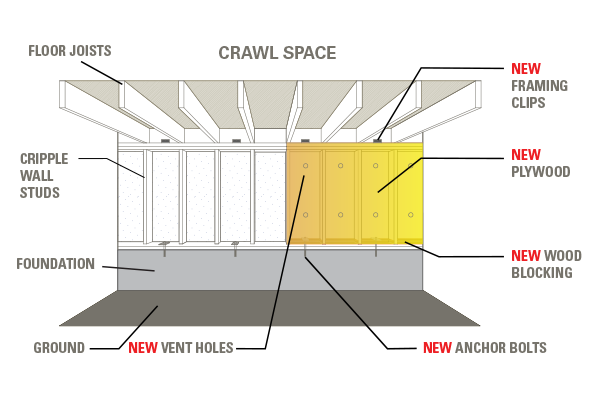In a CEA Brace + Bolt (CEA BB) seismic retrofit, the house's foundation is bolted to the frame of the house and if cripple walls exist in the crawl space of the home, they are braced. Bracing and bolting help prevent the house from sliding or toppling off of its foundation during an earthquake. A CEA BB seismic retrofit is only done on wood-framed, pre-1980 homes with a raised foundation.
Receive Up to $3,000 Toward an Earthquake Retrofit
The CEA BB program helps homeowners lessen the potential for damage during an earthquake. CEA BB offers an incentive grant of up to $3,000 toward a code-compliant seismic retrofit for houses that qualify.
A Brace and Bolt Retrofit
In a CEA BB retrofit, the foundation is bolted, and if there is a cripple wall, it is braced.
- Bolting: adding anchor bolts in the crawl space to help prevent the home from sliding.
- Bracing: adding plywood to the cripple walls to stiffen them and help prevent the home from collapsing.
CEA BB Participating Policyholders
Qualifying policyholders are invited into the program. For a retrofit to qualify for an incentive grant, a permit must not be issued or retrofit work started before CEA notifies a policyholder they have been accepted into the program.
Which Retrofit: Brace and Bolt? Or Bolt Only?
The CEA BB retrofit can be a brace and bolt retrofit or a bolt-only retrofit—it all depends on what's under your house.
Brace and Bolt Retrofit
If there are short walls (known as cripple walls) between the wooden frame of the house and the foundation in the crawl space under the house, this house would need a brace and bolt retrofit. In a brace and bolt retrofit the cripple walls are braced with sheets of plywood, and the foundation is bolted to the wood frame of the house.
- Bracing is where plywood sheets are attached along the cripple walls to strengthen the structure between the house and the crawl space.
- Bolting is when large anchor bolts are used to bolt the wooden frame of the house to the concrete foundation, to strengthen the connection between the two.
Bolt-Only Retrofit
If the house's wood frame sits directly on the foundation (known as a stem wall) in the crawl space under the house, this house would need a bolt-only retrofit, where the foundation is bolted to the wood frame of the house.
- Bolting is when large anchor bolts or foundation plates are used to bolt the wooden frame of the house to the concrete foundation, to strengthen the connection between the two.
Strapping the Water Heater
During every CEA BB retrofit, the water heater is also properly strapped and braced, which helps prevent water and fire damage, and also protects the home's water supply.
- Earthquake Country Alliance has resources for strapping and bracing your water heater.
Who Can I Hire to Complete the Retrofit? Can I Do it Myself?
Most homeowners decide to hire a contractor to do the retrofit work instead of doing it themselves. If you hire a contractor to do the retrofit work, we recommend you choose one from the California Residential Mitigation Program's (CRMP) Contractor Directory. Contractors listed in this Directory are trained by FEMA in seismic retrofitting, and are California-licensed general contractors.
Learn more about what you should know before hiring a contractor:
- Review What You Should Know Before Hiring a Contractor (PDF)
- Go to the Contractors State License Board website and confirm the contractor you are considering is:
- Currently licensed in the State of California
- Is in "good standing" with the License Board
If you are a homeowner who is an experienced do-it-yourselfer, you can do the retrofit as an owner-builder. You become the general contractor for your project and assume responsibility for the overall job. See our Do-it-Yourself Tips for more information about what you need to know before deciding to do your own retrofit.
Whether a contractor completes the work, or you do it yourself, a CEA BB retrofit must be done in compliance with California Existing Building Code (CEBC), Chapter A3 (see pages 125 - 142). Chapter A3 is specific to light, wood-frame houses.
- Learn more about the CEA BB Program Rules.
How Much Does a Typical Retrofit Cost?
A typical retrofit completed by a licensed contractor may cost between $3,000 and $7,000 depending on the location and size of the house, contractor fees, and the amount of materials and work involved. If you do the work yourself, a retrofit can cost less than $3,000
CEA Brace + Bolt Program FAQs
A. California has two-thirds of our nation's earthquake risk. Structures that lack adequate sill plate bolting and cripple-wall bracing are more susceptible to earthquake damage.
The frames of older houses are often not bolted to their foundations, and their cripple walls may lack bracing. Houses without adequate bolting and bracing can slide or topple off their foundation during an earthquake, requiring potentially very expensive repairs. But this serious damage can be prevented with a proper seismic retrofit.
You may be eligible for financial help to pay for your house's retrofit. Learn more about our program—Earthquake Brace + Bolt—that offer grants of up to $3,000 to help pay for a seismic retrofit.
CEA policyholders with properly retrofitted houses are eligible for a discount of up to 25% off your CEA policy premium.
A. There is no such thing as an “earthquake-proof structure.” But there are straightforward measures that will likely reduce the potential for (or severity of) earthquake damage. The California Existing Building Code (CEBC) states that its retrofit provisions are "minimum standards intended to improve the seismic performance of residential buildings; however, they will not necessarily prevent earthquake damage."
A. If your home has been properly retrofitted, you can receive up to 25% off of your CEA policy premium. Learn more about how to qualify for this Hazard Reduction Discount.

